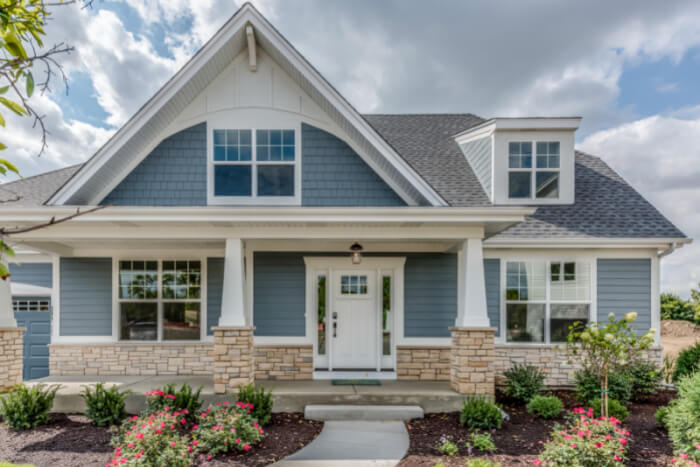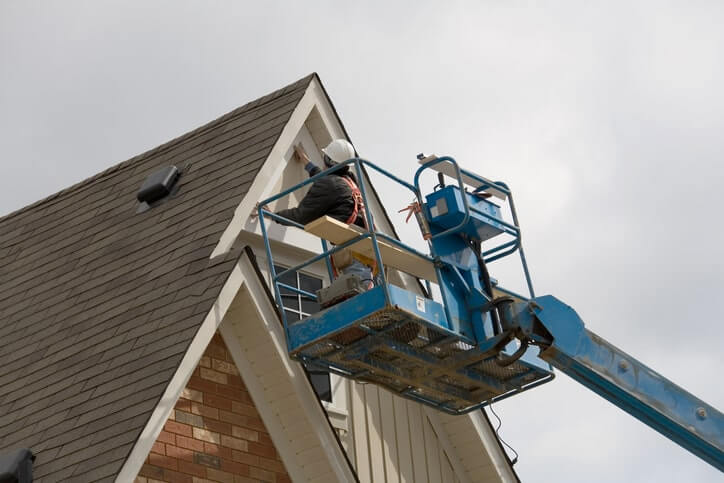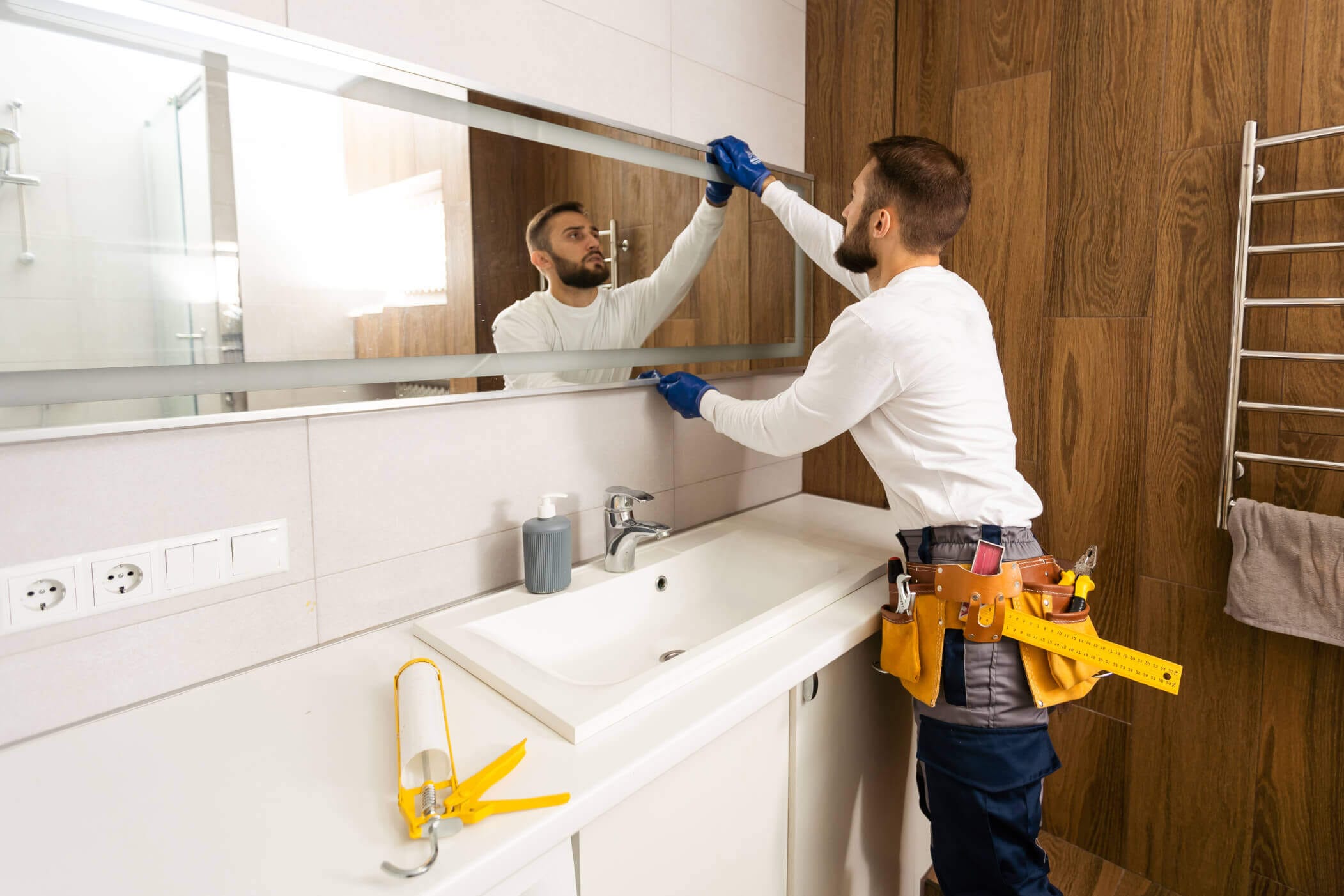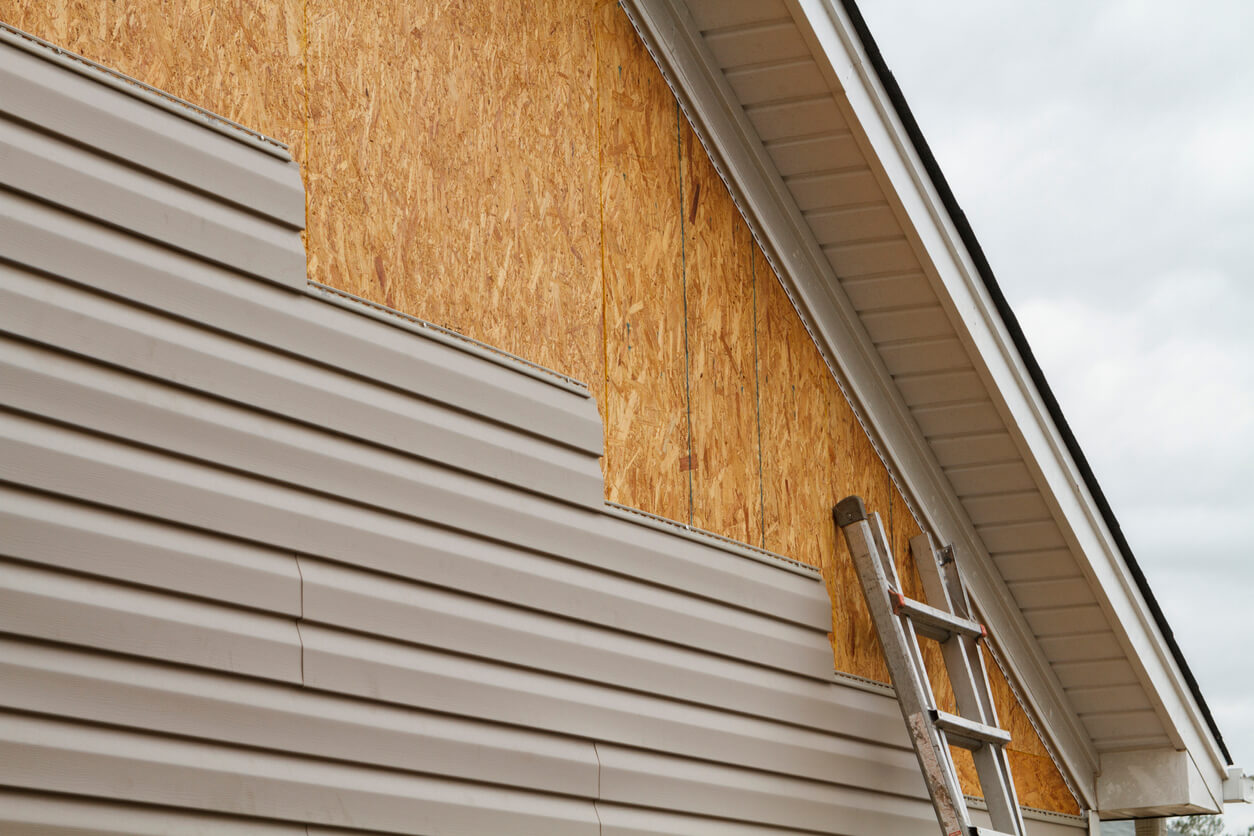What Is Siding?
Siding is a protective material applied to the exterior of your home to shield it from weather elements, enhance energy efficiency, and improve curb appeal. Siding comes in a variety of materials, colors, and styles, making it a versatile choice for homeowners. Popular options include vinyl, fiber cement, wood, brick, and stone veneer, each offering unique benefits for durability, aesthetics, and maintenance.
Choosing the right siding for your home depends on factors such as climate, budget, and desired aesthetic. High-quality siding not only boosts your home’s value but also provides insulation and weather resistance, ensuring a comfortable living environment year-round.

How Does Home Siding Work?
A siding system serves as your home’s protective exterior, shielding it from weather elements, enhancing energy efficiency, and contributing to its aesthetic appeal. The system comprises several key components that work together to ensure durability and functionality:
- Sheathing: This structural layer, typically made of plywood or oriented strand board (OSB), provides a solid foundation for the siding and adds rigidity to the walls.
- Weather-Resistant Barrier (WRB): Installed over the sheathing, the WRB prevents moisture infiltration, protecting the underlying structure from water damage.
- Siding Material: The outermost layer, available in various materials such as vinyl, fiber cement, wood, or metal, offers the first line of defense against environmental elements and defines the home’s exterior appearance.
- Insulation (Optional): Some siding systems include an additional insulation layer to improve thermal performance and energy efficiency.
- Flashing and Trim: These components seal joints and edges, directing water away from vulnerable areas to prevent leaks and enhance the overall look.
Each component plays a crucial role in protecting your home, maintaining structural integrity, and contributing to energy efficiency.
Frequently Asked Questions
What Are the Different Types of Siding?
There are several main types of siding materials, each designed to meet specific needs, preferences, and climates.
- Vinyl Siding: Affordable and low maintenance, vinyl siding is available in various colors and styles, making it versatile for most homes. It is weather-resistant and suitable for a wide range of climates, though it can crack in extreme cold.
- Fiber Cement Siding: Durable and fire-resistant, fiber cement siding mimics the appearance of wood or stone. It is ideal for humid or fire-prone areas, though its heavier weight may require additional structural support.
- Wood Siding: Known for its natural beauty, wood siding provides a classic, rustic look. It requires regular maintenance to prevent rot and insect damage and is best suited for dry, mild climates.
- Stucco Siding: Popular in hot and dry climates, stucco siding is made from a mixture of cement, sand, and water. It is energy-efficient and offers excellent durability but may crack in areas with heavy rainfall or earthquakes.
- Brick Siding: Timeless and incredibly durable, brick siding offers excellent resistance to fire and pests. Its cost is higher, but the long lifespan and minimal maintenance make it a great investment.
- Aluminum Siding: Lightweight, durable, and resistant to fire, aluminum siding works well in coastal regions due to its resistance to salt air corrosion. However, it can dent more easily than other materials.
- Engineered Wood Siding: An eco-friendly alternative to natural wood, engineered wood siding is crafted from wood fibers and resins. It is lightweight, durable, and often more affordable than natural wood.
- Stone Veneer Siding: Faux stone veneer offers the look of natural stone at a fraction of the cost. It is lightweight, easy to install, and suitable for accent walls or entire exteriors.
| Siding Type | Material | Best for Climates | Lifespan | Average Cost per Sq. Ft. | Pros | Cons |
|---|---|---|---|---|---|---|
| Vinyl Siding | PVC (Polyvinyl Chloride) | All climates | 20 to 40 years | $3 to $8 | Affordable, low-maintenance, versatile | Can crack in extreme cold |
| Fiber Cement | Cement, Sand, Cellulose | Humid or fire-prone regions | 30 to 50 years | $5 to $10 | Durable, fire-resistant, wood-like look | Heavy, may require skilled installation |
| Wood Siding | Cedar, Redwood | Mild, dry climates | 20 to 40 years | $6 to $12 | Natural beauty, eco-friendly | Requires regular maintenance |
| Brick Siding | Clay or Concrete Bricks | All climates | 50+ years | $8 to $15 | Long lifespan, low maintenance | High upfront cost |
| Stucco Siding | Cement, Sand, Lime | Hot, dry climates | 20 to 30 years | $7 to $14 | Energy-efficient, durable | Prone to cracking in wet climates |
Other Siding Types
Frequently Asked Questions
How to Choose the Right Siding for Your Home
Choosing the right siding system for your home involves considering several factors to ensure durability, energy efficiency, and aesthetic appeal. Each home is unique, so selecting the best siding type depends on your specific needs and circumstances:
- Climate: Your local climate plays a major role in choosing siding material. For instance, fiber cement siding is ideal for humid or fire-prone areas, while stucco siding performs best in hot, dry regions. In areas with freezing temperatures, vinyl siding or engineered wood can provide durability without cracking.
- Home Size and Architecture: Larger homes may benefit from low-maintenance siding like vinyl to minimize upkeep, while traditional or historic homes often look best with wood siding or stone veneer for authenticity.
- Budget: Vinyl siding is one of the most cost-effective options, whereas materials like brick or stone veneer come with higher upfront costs but offer long-term value and durability. Use a Siding Cost Calculator to estimate your budget.
- Energy Efficiency: Insulated siding options, such as insulated vinyl or fiber cement paired with foam underlayment, can improve your home’s energy efficiency and lower utility bills.
- Maintenance Preferences: If you prefer minimal upkeep, vinyl, fiber cement, or aluminum siding are great choices. However, wood siding, while beautiful, requires regular maintenance to protect against rot and pests.
- Aesthetic Goals: Choose a material and color that complement your home’s architectural style. For example, stone veneer or brick siding works well for rustic or classic homes, while sleek stucco or fiber cement suits modern designs.
By carefully evaluating these factors, you can select a siding system that not only protects your home but also enhances its value and appearance. For further guidance, consult a professional siding contractor to explore the best options for your home.
Common Siding Parts to Know
Understanding the main components of a siding system can help you make informed decisions when selecting, installing, or maintaining siding. Each part works together to protect your home and ensure its functionality and appearance.
1. Sheathing
Sheathing is a structural layer, typically made from plywood or oriented strand board (OSB), that provides a solid base for attaching siding. It also adds rigidity and strength to the walls of your home.
2. Weather-Resistant Barrier (WRB)
This layer, often made from materials like house wrap or felt paper, protects your home from moisture infiltration. It is installed between the sheathing and the siding material to keep water out while allowing vapor to escape.
3. Siding Panels
Siding panels are the visible exterior layer of the system, available in materials like vinyl, fiber cement, wood, or brick. They provide the primary defense against weather elements and contribute to your home’s aesthetic appeal.
4. Insulation (Optional)
Insulated siding or foam board insulation can be installed beneath the siding to improve thermal resistance, reduce energy loss, and enhance indoor comfort.
5. Flashing
Flashing is thin, waterproof material, often made from metal or plastic, used to direct water away from vulnerable areas such as window and door edges, corners, and rooflines. It helps prevent leaks and extends the life of the siding.
6. Trims and Fascia
These decorative and functional elements cover the edges and seams of siding panels. They provide a polished look while sealing gaps to protect against moisture and pests.
7. Soffit
Soffits are located under the roof overhang and help ventilate the attic while protecting the underside of the roof from weather damage. They are typically made from vinyl, aluminum, or wood.
By understanding these key siding components, you’ll be better equipped to evaluate your options and ensure your siding system is installed correctly and efficiently.
Frequently Asked Questions
How to Maintain Your Home Siding
Proper maintenance of your siding system is essential for preserving its durability, functionality, and appearance. Regular care can prevent costly repairs and extend the lifespan of your siding. Here are some recommended practices to keep your siding in top condition:
1. Regular Cleaning
Cleaning your siding annually helps prevent dirt, mold, and mildew buildup that can damage the material over time. Use a garden hose and a soft-bristle brush to clean most siding types. For tougher stains, a mild detergent or siding-specific cleaner may be required. Be cautious with pressure washers, as they can damage certain materials like wood or stucco.
2. Inspect for Damage
Inspect your siding at least twice a year, focusing on cracks, warping, or loose panels, especially after storms. Pay close attention to areas near windows, doors, and rooflines where damage is more likely to occur. Promptly repair or replace any damaged sections to prevent moisture infiltration and further structural issues.
3. Repaint or Restain as Needed
Certain siding materials, such as wood and fiber cement, require periodic repainting or staining to maintain their protective barrier. Signs like peeling, cracking, or fading indicate it’s time for a fresh coat of paint or stain. Following manufacturer guidelines for reapplication will help prolong the siding’s lifespan.
4. Protect Against Moisture
Ensure your gutters and downspouts are free of debris and functioning properly to direct water away from your siding. Check caulking and flashing around windows, doors, and other joints to prevent water from seeping behind the siding. Addressing moisture issues early can prevent costly repairs down the line.
5. Prevent Pest Infestation
Pests, such as termites or carpenter ants, can damage siding, especially wood. Inspect for signs of infestation, including small holes or wood damage. Use pest-resistant treatments and seal any gaps to protect your siding system.
6. Address Issues Promptly
If you notice any loose panels, cracks, or other visible damage, address them immediately. Small cracks can often be repaired with caulk, but more extensive damage may require professional replacement. Early intervention can prevent minor issues from becoming major problems.

Frequently Asked Questions
How Much Should It Cost to Install Siding?
The cost of siding replacement or installation depends on several factors, including the type of material, the size of your home, labor expenses, and any additional upgrades. For a typical 2,000-square-foot home, the average cost for mid-range siding is around $17,200, or approximately $8.60 per square foot installed. This estimate is on the higher end of the national cost range, which spans from $2,560 to $20,400.
This average includes pricing for five popular siding materials: vinyl, metal, wood, fiber cement, and stucco. Each of these options varies in cost and installation complexity. Vinyl siding, for example, is one of the most affordable choices at $3 to $8 per square foot, whereas fiber cement and stucco are premium options, costing between $7 and $14 per square foot.
Labor also plays a significant role in the overall expense. The complexity of your home’s design — such as multi-story layouts or intricate architectural features — can increase labor costs. Additional factors like removing old siding, repairing damaged sheathing, or installing insulation beneath the new siding can further impact the total cost of the project.
Working with a professional contractor allows you to get an accurate estimate tailored to your specific needs. High-quality materials and expert installation may require a larger upfront investment, but they provide long-term benefits, including enhanced durability, energy efficiency, and improved curb appeal.
Frequently Asked Questions
How to Choose the Right Siding Contractor
When it comes to replacing or installing siding, selecting a reputable siding contractor is crucial to ensure quality results and long-term durability. Here are some key points to consider:
- Get Multiple Quotes: Don’t settle for the first quote you receive. Gather estimates from several contractors to compare prices, materials, and timelines. Reviewing multiple options allows you to make an informed decision that fits your budget and project goals.
- Compare Quotes Carefully: Make sure each quote includes all expected costs, such as materials, labor, permits, and additional fees. A detailed and transparent estimate will help you avoid unexpected expenses during the project.
- Vet the Contractor: Ask contractors about their experience with siding projects similar to yours and request references from previous clients. Checking reviews and ratings online can also provide insight into their reputation and quality of work.
- Look for a Licensed and Insured Contractor: Verify that the contractor is licensed in your state and carries general liability and workers’ compensation insurance. This protects you from liability in case of accidents and ensures the contractor meets professional standards.
- Be Cautious of Large Upfront Payments: A trustworthy contractor typically requires a small deposit to secure the project, not a large upfront payment. Be wary of contractors who demand significant payments before any work has begun.
- Ask About Warranties: Confirm that the contractor provides warranties on both materials and labor. A reliable siding contractor should stand by their work and offer a warranty to cover any issues that arise post-installation.

Frequently Asked Questions
Costs, Rebates, and Environmental Impact of Siding Systems
When investing in a siding system, financial and environmental considerations are key factors to weigh. The cost of siding replacement varies widely depending on the material, labor, and additional features. Homeowners looking to reduce upfront expenses may benefit from financial incentives such as rebates and tax credits for installing energy-efficient or environmentally friendly siding materials. Many state, utility, and federal programs provide incentives for eco-friendly siding, particularly those that enhance insulation and reduce energy consumption.
Eco-friendly siding options can significantly impact your home’s energy efficiency and carbon footprint. Materials like fiber cement, engineered wood, and even insulated vinyl are considered sustainable as they are durable and often include recycled or renewable content. Additionally, insulated siding improves thermal resistance, reducing energy loss and helping lower heating and cooling costs. By selecting a sustainable siding material, you can enhance your home’s energy performance while contributing to a healthier environment.
Frequently Asked Questions
Ready to get your project started?
Let us find the best Siding pros in your area, then easily request quotes, book a contractor, and get the job done. It's that easy.

Homeowner Resources
Here are the top articles that homeowners found useful when planning their siding project and navigating the contractor hiring process:

Real Stories, Real Success
See how our solutions empower homeowner projects and experiences.


